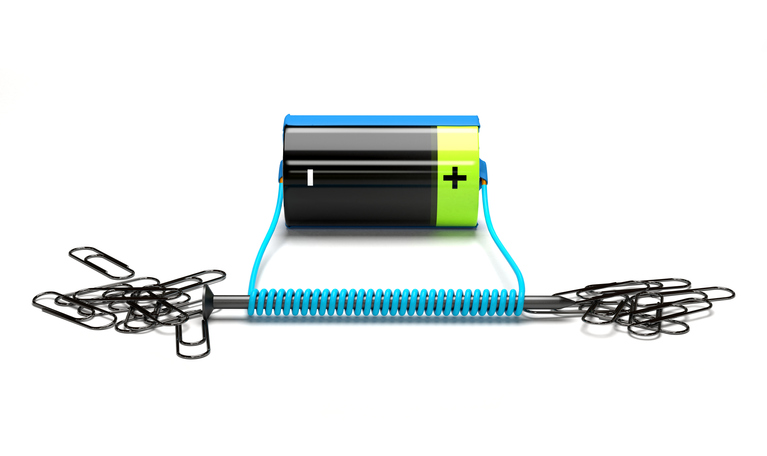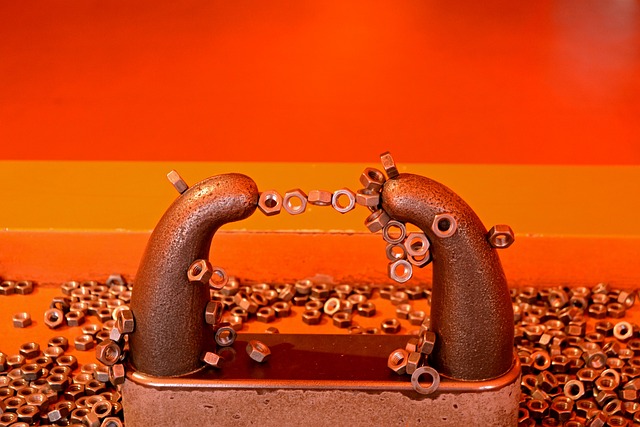
Let’s Start with a Piece of Metal
Let’s use iron for example. Touch it with another piece of iron and what happens? Nothing! Now take a bare wire, copper preferred. Wrap the copper wire around one of the pieces of iron and what happens? Still nothing!
Now grab both ends of the copper wire and connect it to a battery. What happens? Still nothing – at least nothing noticeable that the naked eye can see!
What is happening when the wires connect to the battery (called a circuit) is that the electrons were random before the circuit was completed and they straightened out, like a row of marching soldiers after the circuit is complete.
These marching electrons will point and move towards the pole ( polarity) of the battery it is connected to. Now let’s get a little more technically correct and call these marching electrons an electric current, and as these electrons (current) are moving through the wire, a magnetic field is produced.
When There is Electric Current, There is a Magnetic Field

But Just What is This Magnetic Field?
If we pick up the other piece of iron (which does not have the copper wire around it) and place it near the iron piece that has the wire wrapped (and thus the electric current), that isolated piece of iron suddenly moves toward the electrified one.
The reason why the iron pieces attract each other is that the iron piece with the copper wire wrapped around it (called a coil) becomes magnetic. And so, we have just created an electromagnet!
For the video below, you might want to put your thinking caps on as it explains pretty well how electromagnetic forces are derived (hint: when electrons move through a wire). We suggest those that who are in school and/or have an absorption for learning continue to this video.
For those that would like to bypass such items as Maxwell’s equations and just want a cheat sheet of what is the criteria for an electromagnetic field, see our summary below.
How Electromagnets are Made
An electromagnet can be made out of any type of metal, but iron and nickel are the ones most often used. Nickel magnets are stronger than iron magnets, but iron is cheaper.
Iron is found in most scrap yards, or you can buy it from a hardware store. The first step in making an electromagnet is to create a wire that is wrapped with a coil of metal several times. This is known as an electromagnet coil. The coil has to be wrapped around a core, which is made out of a non-magnetic material.
The Magnetic Field

The electromagnetic field is the region of energy surrounding a magnet. The magnetic field is perpendicular to the path where the electrons flow.
Why are Electromagnets Important?
Electromagnets are important because they can be used to power items and devices that are used by us every day. Motors and generators are just two examples. They are also used in toys, as a way of moving things around in a car or even to move things in a factory.
They are also useful because they’re easily controllable. If you want to turn the electromagnet off, you simply turn off the electric current running through it. If you want to turn it back on, you can simply turn it back on again.
Types of Magnets
There are two types: temporary and permanent. Temporary magnets are only magnetic while electricity is running through them. Permanent magnets remain magnetic no matter what happens. This is because these magnets are not electrified. An example is the ones stuck to your fridge or another metal surface.
Conclusion
Magnetism is created when electrons are in movement. In a practical sense, this means that if you connect a wire to a battery (power source), electrons will move from the negative pole to the positive pole of the battery.
When this happens, a force is created in addition to the electrical force, which is the magnetic force. This magnetic force ‘pushes’ perpendicular to electrical force (current), so any metal that has magnetic properties will be attracted to this force and move towards it accordingly.
The magnetic force can be strengthened by any of the following criteria.
-
- Take the straight wire and curl it around the medium, usually an iron bar. The result is called a coil.
- Wiring the coil more will cause the magnetic field to strengthen.
- Increasing the current; that is, increasing the speed at which the electrons travel through the coiled wire will also strengthen the magnetic field.
The practical applications of electromagnets are the ability to cause an entity to move because of this force, such as what happens inside a motor.
